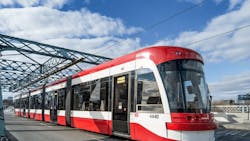Canadian Urban Transit Association releases report on policy intersections between housing and public transit
The Canadian Urban Transit Association (CUTA) released a comprehensive report on the policy intersections between housing and public transit. The report emphasizes the role of public transit in shaping housing development in Canada, improving affordability and reducing greenhouse gas emissions, as well as presents a series of policy recommendations aimed at federal, provincial and municipal governments, as well as transit agencies and other partners.
“Housing and transit are often planned separately, resulting in new housing developments with little to no transit services or new transit projects without the residential density to increase ridership,” said CUTA President Marco D’Angelo. “This disjointed approach leads to longer commutes, increased transit operating costs and reduced progress on other policy goals. Housing and transportation are intertwined and their solutions must be intertwined as well.”
CUTA addressed five policy themes:
- Activating land for transit-oriented development (TOD).
- Encouraging housing development near existing transit stations and properties.
- Ensuring inclusivity and proposes that governments incentivize developers of TODs to include rental and affordable housing units.
- Streamlining approval processes.
- Prioritizing transit investments that pair housing and ridership growth.
“Time is of the essence,” D’Angelo said. “It takes far too long for new housing and new transit to get built. Delays are costly and constrain economic and social progress.”
The report calls for coordinated rezoning that can lead to cost savings for new rapid transit projects. It also notes municipalities should accelerate the timeline for reviewing development applications within defined TOD areas.
Canada’s proposed federal Permanent Public Transit Fund, scheduled to come online in 2026, offers an opportunity for enhancing the integration of housing and public transit in the country. The federal government has signaled that integrating housing supply considerations will be an important co-benefit of this program, which can incentivize provinces and municipalities to boost housing supply, ensuring alignment between public transit and housing needs.
The report’s conclusions were developed through a series of in-person consultation sessions with municipalities, provincial governments, developers, housing stakeholders and academies were conducted in cities throughout the country.
“Our report is not just a checklist, it’s a call to action,” D’Angelo said. “With a rising population and ongoing housing supply and affordability issues, inaction is not an option.”
The full report is available on CUTA’s website.
